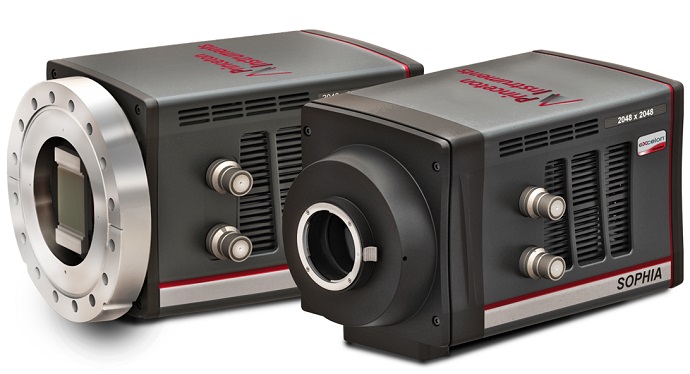February 16, 2016 — New Jersey, USA. Princeton Instruments is pleased to introduce its SOPHIA series, a line of next-generation, ultra-low-noise cameras engineered to address even the most demanding low-light-level scientific applications. These cameras feature Princeton Instruments’ proprietary new ArcTec™ thermoelectric cooling technology. High frame rates and outstanding sensitivity make SOPHIA ideal for a diverse range of applications, including astronomy, in vivo small-animal imaging, chemiluminescence, soft x-ray imaging, and spectroscopy.
Based on a 2k x 2k sensor format, SOPHIA’s multiple-port, back-illuminated CCDs leverage patented Princeton Instruments eXcelon® technology and provide an unprecedented combination of large pixel size, fast pixel speed, and minimal pixel noise. SOPHIA’s 30.7 mm x 30.7 mm photosensitive array with 15 μm x 15 μm pixels detects 23% more photons per pixel than equivalent back-illuminated sensors (2k x 2k, >95% peak quantum efficiency) that have 13.5 μm x 13.5 μm pixels. Not only do SOPHIA cameras detect more photons, they keep the noise of each pixel low. ArcTec cooling technology minimizes dark noise by cooling the CCD to less than -90°C using only air assist; eXcelon sensor technology broadens sensitivity over a wider wavelength range and reduces unwanted fringes in the near-infrared region, further improving signal-to-noise ratio. Using the latest USB 3.0 data interface and multiple-port readout capabilities up to 16 MHz, SOPHIA increases frame rates by as much as 4x while delivering the low noise typically attributed to slow-scan detectors.
New SOPHIA cameras are supported by 64-bit LightField® imaging and spectroscopy software, which provides hundreds of user enhancements, includes a powerful built-in math engine to perform live data analysis, and permits direct control from third-party packages such as National Instruments’ LabVIEW®, Mathworks’ MATLAB®, and EPICS synchrotron software. One of the camera variants (i.e., the SOPHIA-XO) uses no antireflective coatings and employs an open-nose design in order to facilitate soft x-ray detection.
“Over the past 35 years, Princeton Instruments has produced iconic cameras, spectrometers, and software — advanced scientific tools utilized by leading researchers and Nobel laureates around the world. SOPHIA extends this lineage of innovation,” comments Ravi Guntupalli, vice president of sales and marketing at Princeton Instruments. “With ArcTec cooling technology, brand-new readout electronics, and a USB 3.0 interface all integrated via our acclaimed LightField software, we believe no other scientific-grade low-light detector can match SOPHIA’s performance and ease of use.”













